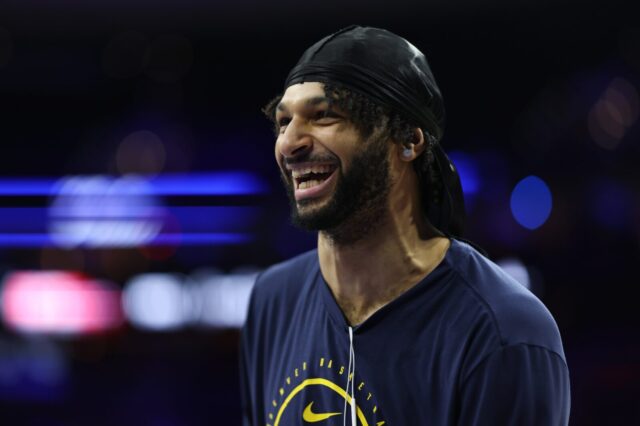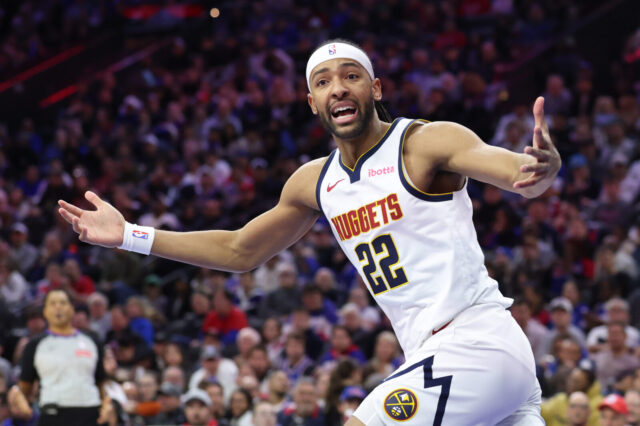After a couple weeks of desert heat, the Denver Nuggets finally wrapped up their Las Vegas Summer League last Saturday night. The team went 2-3, finishing thing off with a win against the New Orleans Pelicans. Almost every game was close until the last few minutes, and several prospective Nuggets played pretty well under casual scrutiny.
Of course, this trip began in very negative fashion, and there were a few storylines to watch that didn’t go the way the Nuggets hoped they would go. There were some positives too, but the most important moment of all happened in the closing minutes of Game 1 when DaRon Holmes was lost for the season.
There’s plenty to discuss. Six takeaways for each of the six players connected to Denver’s official roster. Let’s start with the toughest part of Denver’s Las Vegas trip these last two weeks:
The DaRon Holmes injury is just horrible
DaRon Holmes tore his achilles going for a rebound in the first game. It was a horrible moment. That can be universally agreed upon. Holmes had played well in his first game and was fitting into what the Nuggets were asking him to do. Unfortunately, bad things happen sometimes, and his debut with the Nuggets will take significantly longer than anticipated.
Otw to surgery, wanted to thank everyone who reached out it really means a lot ! It was very cool to see how many people care, people I would never expect, human nature can be a beautiful thing man❣️
With that being said… I’ll be back and better soon! Let’s get to work🎯
— DaRon Holmes II (@DaRonagon) July 15, 2024
Holmes had successful surgery and is expected to miss the entire 2024-25 NBA season. He will eventually make his rookie debut with Denver down the line, but for the next year, the Nuggets will have to survive without him. The signing of Dario Šarić in free agency becomes that much more important for the team. Denver’s biggest weakness last season was their frontcourt depth, having lost Jeff Green in free agency and Vlatko Čančar to a season long injury.
Now with Holmes out, Denver will hope Čančar recovers enough to provide some consistent minutes while Šarić remains the first big man off the bench. There’s no telling what the roles of Zeke Nnaji and Deandre Jordan (who’s expected to sign soon) will ultimately be.
Either way, Holmes was supposed to be the breath of fresh air in Denver’s regular season rotation. Now, all the Nuggets can hope for is a full recovery for the 22nd overall pick.
Julian Strawther is ready for a real NBA role
The second most important thing from Las Vegas for the Nuggets was the improvements of Julian Strawther.
In 2023, Strawther played all five Summer Games as a rookie, averaging 18.2 points, 4.6 rebounds, and 1.8 assists per game on 40.0 FG% and 34.0 3P%. He had some up-and-down showings, but he looked the part of a future scoring wing.
In 2024, Strawther upped his production across the board in the only two Summer Games he played, averaging 28.5 points, 4.0 rebounds, and 3.0 assists per game on 42.5 FG% and 40.9 3P%. In addition, Strawther got to the free throw line 20 times in two games, compared to 25 times in five games the previous year.
Strawther appeared to be more comfortable operating as an all-around scorer. His 3-point volume was roughly the same, but his floater game was more polished, as was his ability to create contact at the rim and draw fouls. That will translate to the next level well, and it should give Nuggets fans some confidence that he can fill a similar role for Denver’s roster.
How many minutes Strawther ultimately plays will be a question, but it will be at least twice as many as the 545 he played in his rookie season. Effectively, he has to play for a Nuggets team that suddenly lacks wing depth after the departures of Kentavious Caldwell-Pope and Justin Holiday.
Jalen Pickett had a Las Vegas to forget
Perhaps it’s the up-and-down, unstructured environment of Summer League. Perhaps it was the desert heat. Perhaps it was just a bad week. Whatever the reason, Jalen Pickett really struggled in three games and played just nine minutes in the fourth before sitting down entirely. The Nuggets shared that Pickett had sustained a groin injury, via Vinny Benedetto of the Denver Gazzette, so perhaps that contributed to some of his struggles.
Jalen Pickett is being held out of the Nuggets’ Summer League finale due to left groin soreness, I’m told. Sounds like it started bothering him during Thursday’s game. Team doesn’t want to risk anything with the second-year guard.
— Vinny Benedetto (@VBenedetto) July 21, 2024
Whatever the case, Pickett averaged a paltry 3.5 points, 2.8 assists, and 2.8 rebounds in 25 minutes per game in Las Vegas. He didn’t record a single steal defensively. He shot 20.8% from the field and 12.5% from 3-point range. Those are abysmal numbers for a second-year guard hoping to break into Denver’s rotation. More than the numbers though, Pickett just looked extremely uncomfortable on the floor. Perhaps that had something to do with the aforementioned groin injury.
With the addition of Russell Westbrook looming in the background, there’s a lot of pressure on Pickett to prove he belongs in a short amount of time. He turns 25 on Oct. 22, and if this upcoming year doesn’t end up becoming anything for him, that will affect his longterm prospects in the NBA.
There was a reason the Nuggets drafted him. Calvin Booth believes in Pickett’s talent and skill set. Whether it ultimately works for Pickett in the NBA is up in the air, and outings like Pickett had in Vegas aren’t going to earn him more playing time in Denver’s rotation.
Hunter Tyson was up-and-down
Like Pickett, Hunter Tyson was in his second NBA season and expected to show additional flashes and comfort level at his second Summer League. What he ultimately showed was a bit more shaky, averaging 15.2 points, 4.6 rebounds, and 1.8 assists per game on 31.9 FG%. That was the lowest FG% among all players to average at least 15 points per game and the third lowest among players to attempt at least 13 shots per game.
Of course, Tyson isn’t going to fill a volume scoring role at the NBA level. The ideal spot for him in a rotation is as a bench spacing small forward or power forward, depending on the situation. Tyson’s jumper is clearly high level, despite shooting just 31.4% from three-point range this time around. That’s a skill he can use at the NBA level.
The real question is whether he can defend at the NBA level. Too many times, he was late on a closeout or didn’t have the athleticism to recover effectively. He held his own against the strength of Indiana Pacers forward Jarace Walker, but against quicker more agile forwards, he struggled. Having just turned 24 years old himself, is there much more athletic development in Tyson’s future? If not, he has to master the footwork and basketball IQ aspects of defending. It’s hard to envision a role for him on the Nuggets if he can’t survive defensively.
Trey Alexander is an NBA player
Outside of perhaps Strawther, Trey Alexander was the most impressive and surprising player on the Nuggets summer roster. The rookie out of Creighton averaged an impressive 17.2 points, 5.8 rebounds, and 2.8 assists per game on impressive shooting efficiency. His comfort level stood out in his ability to create a shot for himself consistently, especially in clutch time. Alexander consistently created space off the dribble and often turned those possessions into great shots for the Nuggets.
Alexander played so well that he caught some national attention for his Las Vegas performance.
Trey Alexander Summer League (5 GP):
30.0 MPG
17.2 PPG
68.8 TS%
47.8 3P%—4.6 3PA/g
5.8 RPG
2.8 APG
1.6 SPG + BPG
+20.121yo, 6’4, 6’10.5 wingspan. The Undrafted FA from Creighton signed a two-way with DEN & has showed out at SL—displaying translatable combo-guard skills & feel. pic.twitter.com/KHQm8MWVIv
— NBA University (@NBA_University) July 21, 2024
Who knows whether five summer games will ultimately translate into Alexander being an impactful NBA player, but what’s clear to me is that he deserves an opportunity to prove himself. At 6-foot-4 with a 6-foot-10.5 wingspan, Alexander has enough athletic tools to be a versatile contributor on both ends of the floor. If he can make shots at a high level in the NBA, then there’s (at the very least) a clearly defined bench guard role for him on almost any NBA roster.
If he’s also playing solid defense, getting others involved, getting on the glass, and making clutch plays, then the sky’s the limit.
PJ Hall flashed skills but needs seasoning
PJ Hall was a bit more up-and-down than Alexander was in his minutes, but he still showed a solid foundation that can be built upon for the next year or so. In four games, Hall averaging 11.8 points, 6.5 rebounds, and 2.3 assists in 26.6 minutes per game. His scoring efficiency wasn’t high, but he showed a comfort level attempting three-pointers and made his free throws at a high level.
Hall’s biggest issue heading into the NBA is his size for the center position. At 6-foot-8 without a ton of rim deterrence, there are going to be natural limitations to him anchoring an NBA defense. He still averaged 1.5 blocks per game at Summer League, but that isn’t a great indication of what NBA level rim protection will look like. I expect there to be some drawbacks.
For that reason, Hall’s three-point spacing needs to be ironclad if he wants to stick in the NBA. He has to be smarter than his competition, and he has to pull opposing team’s centers out of the paint while on offense. If he can do that, there’s reason to believe he can stick at the NBA level. If not, he will have to find another way to be valuable as a second or third center on a roster.



